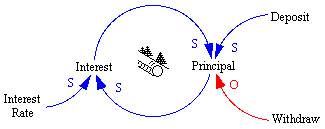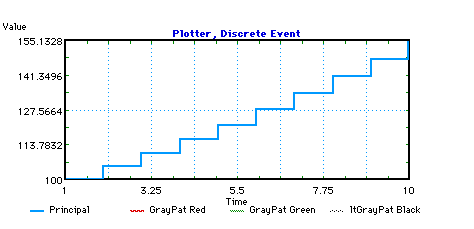
Discrete simulation is a technique where the simulation is advanced from event time to event time rather than using a continuously advancing time clock as in continuous simulation.
Suppose we consider the example of the interaction of the principle and interest associated with a savings account. This can be represented by a systems thinking diagram as follows:

This diagram indicates that Deposits increase the Principal and Withdraws decrease the Principal. Also, the Principal interacts with the Interest Rate on some periodic basis to create Interest. The Interest then serves to increase the Principal.
If we then turn this into a 10 year simulation with the assumptions that the Principal is initially $100, there are no Deposits or Withdraws, and an Interest Rate of 5% is paid once a year it might look like this in Extend.

In the above diagram the Generator function schedules events, which in this particular example just happen to be once a year. When the event happens Interest is computed based on the Principal and the Interest Rate and is tacked on as a value for the event. The event value is extracted in the Get Value function and added to the Principal. The event itself then exits the system.

The above graph show the result of running the model for 10 years. Note that the Interest is computed and added to the Principal at the end of each year and the discrete nature of the simulation is very evident.